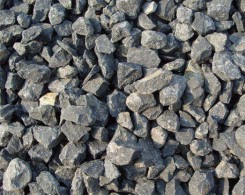
A professional basalt stone and basalt aggregate production enterprise
Main products include basalt stones, specialized basalt stones for highways and high-speed railways, and machine-made basalt stones.

A professional basalt stone and basalt aggregate production enterprise
Main products include basalt stones, specialized basalt stones for highways and high-speed railways, and machine-made basalt stones.




Basalt is a kind of basic extrusive rock, which is a kind of compact or foam structure rock formed by the magma from the volcano after cooling on the surface. It belongs to magmatic rock. Its rock structure often has pore like, almond like, and porphyritic structures, sometimes with large mineral crystals. Unweathered basalt is mainly black and gray, but there are also black brown, dark purple, and gray green. The bulk density of basalt is 2.8-3.3 g/cm3, and its compressive strength is very high with a dense structure, reaching up to 300 MPa or even higher. However, if it contains crystal impurities and pores, its strength will be reduced. Basalt has high durability, with many joints and hexagonal joint surfaces (in basalt lava flows, the vertical condensation surface of the rock often develops into regular hexagonal columnar joints). And it is brittle, so it is not easy to obtain large blocks of stone. Due to common pores and almond structures, although basalt is widely distributed on the surface, there are not many decorative stones that can be used. (However, in daily people's cognition, basalt is still classified as granite.) The structure of basalt: the degree of crystallization and grain size of basalt mainly depend on the cooling rate of magma. If the cooling is slow, such as dropping a few degrees a day, crystals of several millimeters or the same size will be formed; If it is rapidly cooled, such as dropping to Baidu in one minute, small needle shaped, plate-like crystals or amorphous glass will be formed. Therefore, under normal surface conditions, basalt mainly presents a fine-grained to cryptocrystalline or glassy structure, with a few exhibiting a medium grained structure. Often containing olivine, pyroxene, and plagioclase crystals, forming a spotted structure. Spot crystals can aggregate in flowing magma, known as clustered structures. These phenocrysts can form during the process of basaltic magma rising through the crust, or they may form in large magma reservoirs before eruption. The matrix structure undergoes significant changes, with various transition types between fully crystalline and glassy depending on the thickness of the rock flow, the speed of cooling, and the amount of volatile components. However, the main types are intergranular structure, interstitial structure, and hidden structure, with less secondary bright green structure and bright green structure. The structure of basalt is related to its consolidation environment. Basalt formed on land often exhibits rope like structures, blocky structures, and columnar joints; Basalt formed underwater often has pillow like structures. Pore structures and almond structures may appear in various types of basalt. Composition of basalt: The chemical composition of basalt is similar to that of gabbro, mainly consisting of silicon dioxide, aluminum oxide, iron oxide, calcium oxide, magnesium oxide (with a small amount of potassium oxide and sodium oxide). Among them, the SiO2 content is relatively high, generally between 45% and 52%. The K2O+Na2O content is slightly higher than that of intrusive rocks, while the CaO, Fe2O3+FeO, MgO content is slightly lower than that of intrusive rocks. The mineral composition of basalt is mainly composed of basic feldspar and pyroxene, with minor minerals such as olivine, amphibole, and biotite
Classification of basalt: Basalt is divided into many varieties based on its composition minerals, structure, formation environment, etc. According to the different secondary minerals, it can be divided into olivine basalt, perilla pyroxene basalt, etc; According to structural structure, it can be divided into porous basalt, almond shaped basalt, etc; According to their chemical and mineral composition, they can be divided into high alumina basalt, alkaline basalt, and tholeiite; According to alkalinity, it can be divided into alkaline basalt, transitional basalt, tholeiite, calcium alkaline basalt, and potassium basalt; According to the formation environment, it includes continental overflow basalt formed in terrestrial extensional environments and ocean floor basalt formed in submarine expansion zones. The characteristics and uses of basalt: Basalt is also an excellent transportation building stone, especially one of the good building materials in the construction of highways, railways, ports, airports, runways and other projects. It has the characteristics of high compressive strength, low crushing value, wear resistance, low water absorption, weak conductivity, strong corrosion resistance, and strong asphalt adhesion. It is internationally recognized and is a good cornerstone for the development of railway and road transportation. At the same time, basalt has good compressive and flexural properties, as well as good wear resistance and low water absorption rate. It is also a very good building decoration material, which can be widely used for indoor and outdoor decoration, and is mainly used as outdoor stone. Its natural color can coordinate well with the surrounding landscape, making it very suitable for outdoor landscape construction, especially for the selection of floor stone.



